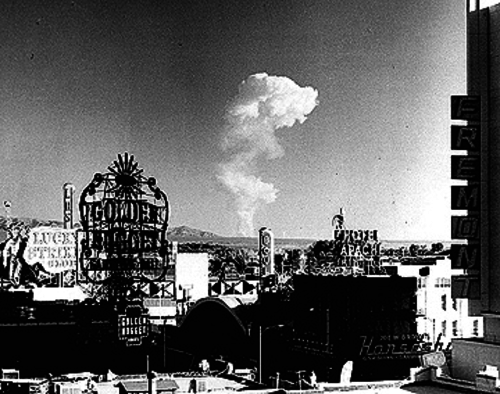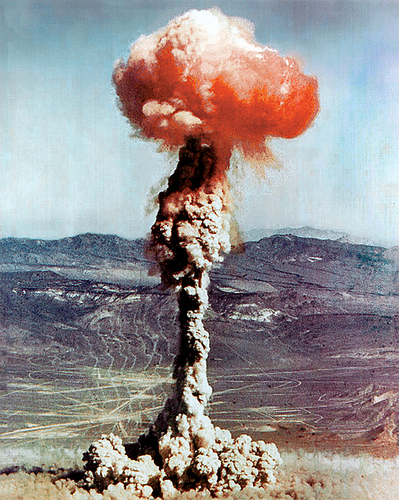Noiser
The Bizarre History of Atomic Tourism in Las Vegas
Play Short History Of... Las Vegas
In 1951, the U.S. Department of Energy started testing nuclear bombs on a strip of desert located just an hour northwest of Las Vegas. You might think that the prospect of city-flattening A-Bombs going off a few miles from the casinos would deter visitors from coming to Vegas. You’d be wrong.

The Great Vegas Rebrand
Before the government started dropping bombs on the Nevada desert, Las Vegas was undergoing a rebrand. In the 30s and 40s, the burgeoning city had established itself as America’s premier gambling hotspot, but the Las Vegas Chamber of Commerce wanted to draw in even more tourists by rebranding Vegas as “the entertainment capital of the world.” By the 1950s, Vegas had become synonymous with dazzling shows, luxurious hotels, and a nightlife that promised endless excitement. When the atomic tests began, the Chamber of Commerce saw it as an opportunity and decided to incorporate them into their entertainment rebrand.
The Nuclear Bomb as Spectacle

Just days after the first bomb was dropped on January 27, 1951, the Las Vegas Chamber of Commerce issued a litany of press releases that described the testing grounds as a new and exciting attraction. Hotels and casinos started organizing “Dawn Bomb Parties” where guests could watch the early morning tests from their rooftop terraces while sipping atomic-themed cocktails.
Schedules of the blasts were drawn up, and people even began planning their trips around nuclear tests. Just six years after the world witnessed the horrifically destructive powers of nuclear weapons in Hiroshima and Nagasaki, souvenir shops on the Strip were selling mushroom cloud postcards and other A-bomb-themed trinkets. Las Vegas had successfully turned a potential deterrent into a macabre attraction.
Atomic Glamour
One of the more bizarre trends to come out of the Vegas bomb craze was atomic beauty pageants. These contests, held around blast dates, would crown a “Miss Atomic Bomb” in celebration of the nuclear tests. Contestants would wear costumes inspired by the bomb, including cotton mushroom cloud swimsuits and dresses adorned with radiation symbols. But it wasn’t just beauty queens who mixed nuclear destruction with glamour—regular women did too. Salons in Las Vegas began offering the “atomic hairdo”—a version of the beehive that mimicked the shape of a mushroom cloud.
The End of an Era

Unsurprisingly, atomic bomb fever began to fall out of fashion as the Cold War amped up and the threat of nuclear destruction at the hands of the Soviets began to feel more tangible. It also didn’t help that residents in Nevada started to complain that their livestock and pets were getting beta particle burns and other ailments from the tests. As a result, the Partial Test Ban Treaty was signed in 1963, which prohibited surface testing. The Nevada Test Site continued to be used for underground tests until 1992, but the days of watching nuclear explosions from the Strip were over.
Atomic Tourism Today
 Though tourists can no longer expect to be treated to the sight of a mushroom cloud after a long night in the casino, remnants of Las Vegas’s atomic past can still be found. Atomic Liquors, built at the height of the bomb craze, remains open to this day, serving up cocktails like the “Atomic Horizon” and the “Thai-me Bomb.” There’s also the National Atomic Testing Museum, which features exhibits filled with artifacts from Vegas’s nuclear years. These sites offer a glimpse into perhaps the most bizarre chapter in Las Vegas’s history.
Though tourists can no longer expect to be treated to the sight of a mushroom cloud after a long night in the casino, remnants of Las Vegas’s atomic past can still be found. Atomic Liquors, built at the height of the bomb craze, remains open to this day, serving up cocktails like the “Atomic Horizon” and the “Thai-me Bomb.” There’s also the National Atomic Testing Museum, which features exhibits filled with artifacts from Vegas’s nuclear years. These sites offer a glimpse into perhaps the most bizarre chapter in Las Vegas’s history.